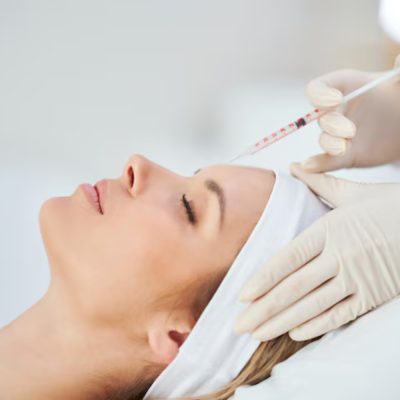Botox
Botox treatment is one of the most popular and widely used cosmetic procedures for reducing the appearance of fine lines and wrinkles. It involves the injection of Botulinum toxin, a purified protein that temporarily relaxes the muscles responsible for facial expressions, resulting in smoother, younger-looking skin. Beyond aesthetics, Botox is also used to treat hyperhidrosis (excessive sweating from the underarms, palms or feet).

What is Botox?
Botox is a neurotoxin derived from the bacterium Clostridium botulinum. When injected into specific facial muscles, it blocks nerve signals that cause muscle contractions, thus softening the appearance of dynamic wrinkles— those formed due to repeated facial movements such as frowning or squinting. The effects of Botox typically last between three to six months, depending on the area treated and the individual’s response to the treatment. Botox is FDA-approved for cosmetic use and is considered safe when administered by a trained and qualified dermatologist.
Method & Treatment of Botox
Treatment Procedure
Consultation
A consultation with a qualified dermatologist is essential to assess the patient’s skin concerns, discuss goals, and determine the appropriate areas for treatment.
Preparation
The treatment area is properly cleaned, and a topical anesthetic or ice may be applied to minimize discomfort.
Injection
Using a fine needle, Botox is injected into the targeted muscles. The number of injections varies depending on the size of the treatment area and the depth of the wrinkles.
Duration
The procedure typically takes about 10-20 minutes, making it a quick and convenient option for patients.
Post-Treatment
Patients are advised to avoid lying down or massaging the treated area for at least four hours post-procedure to prevent the toxin from spreading to unintended muscles.
Results
Results start to become visible within 3-5 days, with full effects noticeable in about 10-14 days. The skin appears smoother, and the wrinkles get significantly reduced, giving a more youthful appearance.
Applied Areas for Botox Treatment
Botox can be used to treat a variety of facial and non-facial areas:
Forehead Lines
Reduces horizontal lines caused by raising the eyebrows.
Glabellar Lines
Softens the “11” lines between the eyebrows.
Crow’s Feet
Minimizes lines around the outer corners of the eyes.
Bunny Lines
Reduces lines on the bridge of the nose that appear when scrunching the nose.
Lip Lines
Diminishes vertical lines around the mouth, also known as smoker’s lines.
Jawline Contouring
Slims the jawline by relaxing the masseter muscles, useful for patients with a square jawline.
Neck Bands
Reduces the appearance of vertical neck bands, also known as platysmal bands.
Hyperhidrosis
Treats excessive sweating, particularly under the arms, on the palms, or soles of the feet.
Precautions and Risks of Botox Treatment
- It is important to disclose any allergies, muscle or nerve conditions, medications, or previous Botox treatments to the dermatologist.
- Patients should avoid blood-thinning medications or supplements at least 24 hours before the procedure to reduce the risk of bruising.
- Botox is not recommended for pregnant or breastfeeding women.
- Mild bruising, swelling, or redness at the injection site is common but typically resolves within a few days.
- Some patients may experience mild headache or flu-like symptoms post-treatment.
- Incorrect injection placement can lead to temporary drooping of the eyelid or uneven results.
- Rarely, allergic reactions may occur, including itching, rash, or difficulty breathing. Patients are carefully monitored during the procedure to minimize these risks.
Post-Procedure Signs to Look Out For
Mild Swelling or Redness: This is normal and should subside within a few hours to days.
Tenderness at Injection Site: Mild discomfort or tenderness may be experienced at the injection sites.
Delayed Results: Full results typically appear within 10-14 days post-treatment, so patience is necessary.
Patients should contact their provider if they experience severe pain, persistent redness, or symptoms of an allergic reaction.
Complementary Cosmetic Procedures for Better Outcomes
To enhance the results of Botox treatment, it can be effectively combined with other cosmetic procedures:
Dermal Fillers
For comprehensive facial rejuvenation, Botox can be paired with fillers to restore volume and enhance facial contours.
Microneedling Radio Frequency (MNRF) with Platelet-Rich Plasma (PRP)
Combining Botox with MNRF and PRP therapy can improve skin texture, reduce fine lines, and promote overall skin health.
Chemical Peels
After Botox, chemical peels can further refine the skin’s surface, reduce pigmentation, and enhance overall complexion.
Hydrafacial
A hydrafacial can be performed to deeply cleanse, exfoliate, and hydrate the skin, complementing the wrinkle-smoothing effects of Botox.
Laser Treatments
Combining laser treatments with Botox can address skin tone, texture, and pigmentation issues for a more even and youthful appearance.
